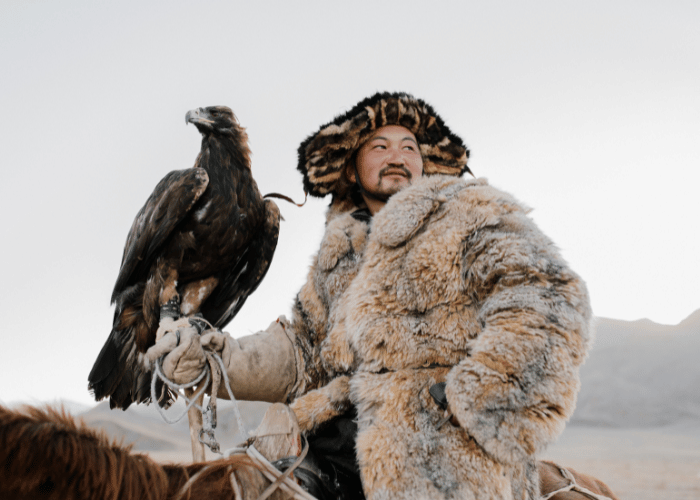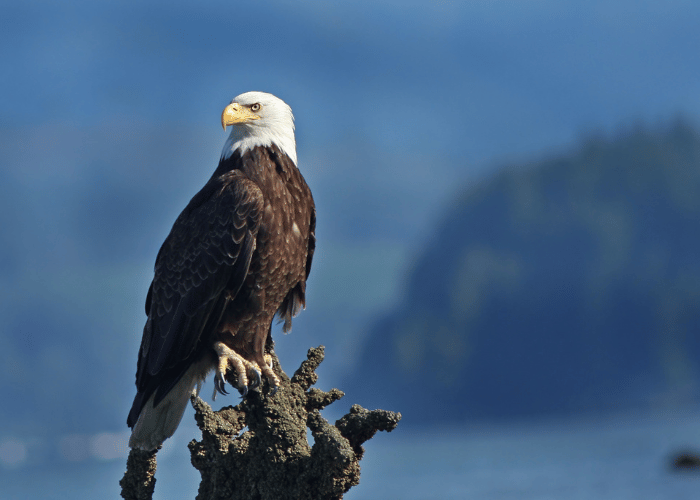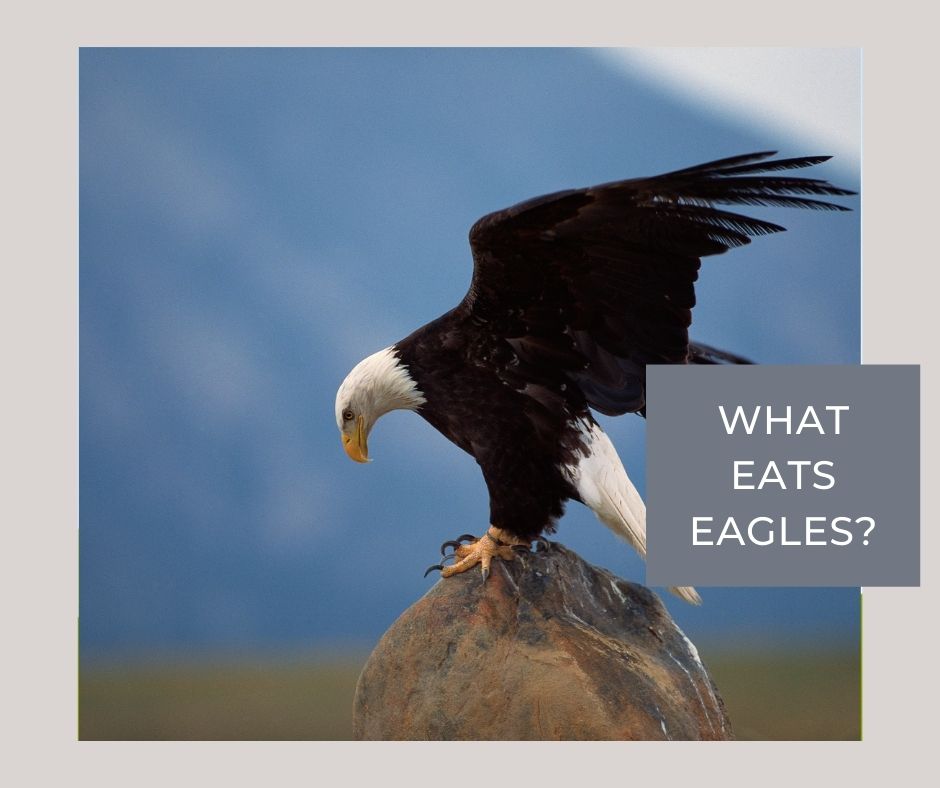What Eats An Eagle
Table of Contents
Ever wondered what eats an eagle? It may seem like a bizarre question considering the eagle’s majestic stature and reputation as a fearsome predator. However, Mother Nature is a complex web of eating and being eaten, and even these kings of the skies aren’t exempt.
Sure, when you picture the soaring eagle, it’s easy to think they’re invincible – superior even. But just like any other creature in the animal kingdom, eagles have predators too. If you’re ready for an adventure that’ll potentially challenge your preconceptions, buckle up! We’re about to dive into the surprising world of eagle predators.
But before we take that leap, it’s important to underline the fact that eagles, largely predators themselves, aren’t typically on the regular menu for any specific animal. These majestic birds possess serious weaponry and strength, making them formidable prey. But in Mother Nature’s survival-themed playground, certain situations make them vulnerable, thus shifting the tables for these otherwise dominant birds of prey.

Understanding Eagles: Majestic Birds of the Sky
Gazing up at the sky, chances are you’ve spotted an eagle soaring gracefully above. These majestic birds aren’t just a sight to behold, they’re fascinating creatures with remarkable traits and behaviors.
So, let’s dive right in and get to know these flying wonders a bit better. Your morning coffee might have given you a caffeine boost, but imagine needing to gulp down a pound or two of food just to get your day started! That’s the reality for eagles who, on an average, consume up to 1 or 2 pounds of food per day. Think about that when you’re next counting your calories!
Now, you’re probably thinking “Alright, but what do they eat?” You’re spot on! Eagles are talented hunters, and don’t limit themselves to one type of food. In fact, their diet spans a wide range from fish, small mammals, snakes and even other birds. Their sharp talons are super tools for grasping their prey while their beaks, strong enough to tear meat apart, do all the ‘dirty work’.
Consider this: eagles are some of the largest birds of prey. While their size varies by species, female eagles are typically larger and stronger, a rarity in the animal kingdom. Their wingspan is impressive too, often reaching over six feet. It’s no wonder they rule the sky!
And talk about a keen eye! An eagle’s vision is incredible, estimated to be 4 to 8 times stronger than that of an average human. This means, an eagle might see a rabbit running almost 3 miles away.
To wrap up this little introduction, let’s slide past the cold, hard facts and venture into the more poetic. Culture and mythology frequently cast eagles as symbols of power and freedom. They’re known for their commanding presence and fierce independence.
We hope this glimpse into the world of eagles has sparked intrigue and deepened your admiration for these powerful birds. As we continue to explore the topic ‘what eats an eagle?’, let’s remember the resilience and strength they display, flying high in the face of adversity.
Natural Enemies: Who Preys on Eagles?
Let’s start with a surprising fact. Eagles, despite being at the top of the avian food chain, do have some natural enemies. Now, you might be squinting your brows in bewilderment. It’s completely understandable. After all, when we think ‘eagle’, we generally picture a fierce, powerful bird soaring high above the mountains. But, like with everything in nature, there’s quite a unique twist in the tale here.
Your first guess might be other birds, and you’re not wrong. Larger birds of prey, known as raptors – specifically the great horned owls and red-tailed hawks – are known to take on eagles. These two species won’t usually tussle with healthy, full-grown eagles, but they don’t shy away from attacking younger ones or stealing eggs. In fact,
| Species | Predatory Behavior |
|---|---|
| Red-tailed Hawk | Known for attacking younger eagles, stealing eggs |
| Great Horned Owl | Likewise, known for preying on younger eagles, eggs |
And it’s not always birds. Surprisingly, larger mammals like wolves and bears are known to attack eagles. These creatures usually target nests, gulping down eggs and fledglings. Here’s a tip: next time you’re out in the wild watching these majestic fliers, take a moment to look around. You may spot one of these unusual suspects lurking nearby.
Let’s dig a bit deeper. Even humans pose serious threats to eagles, though not in the conventional prey-predator way. Human activities, like urbanization and deforestation, can disrupt eagle habitats leading to decline in numbers.
So:
- Red-Tailed Hawks
- Great Horned Owls
- Wolves and bears
- Humans
These are some of the creatures that prey on eagles.
Consider this—you’ve just uncovered another layer of the intricate web that is our ecosystem. It’s a constant dance, isn’t it? A delicate balance of nature’s checks and balances. Remarkable, don’t you think?
Sure, eagles may reign supreme in the skies but down here on Earth, they’ve got quite a few challengers to be wary of. Nature, in all its stunning complexity, never ceases to amaze. There’s always more to learn, isn’t there? So, get out there, keep exploring and keep asking questions. After all, that’s how we keep the wonder alive.

Eagle Predation in Different Habitats
Differences in habitats profoundly influence who or what preys on eagles. You’ll find that eagles, the masters of the sky, indeed have threats lurking out there. Now, let’s delve into some horror scenes from the natural world.
For starters, eagles residing in the forests often face threats from bigger raptors such as owls and hawks. These predators use the element of surprise, attacking eagles while they perch on tree branches. Young eaglets are particularly vulnerable. They’re often targeted by raccoons and bobcats that are skilled at climbing up to their nests.
But hey, don’t think eagles living in the mountains are safe either. Mountainous regions are the stomping grounds of the majestic golden eagles. While adult golden eagles rarely fall prey due to their formidable size, the younger ones aren’t so lucky. Juvenile eagles, with their wings not yet fully developed, fall prey to speedy mountain lions and wolverine attacks.
- Predators in Forests: Owls, hawks, raccoons, bobcats
- Predators in Mountains: Golden eagles, mountain lions, wolverines
Now imagine an eagle dwelling in the coastal areas. Life in coastal regions exposes these awesome creatures to deadly sharks and sneaky sea lions. When eagles swoop down to catch fish close to the water surface they can quickly become a meal themselves. It’s a tough world out there!
Then there’s the chilly Arctic habitat of the snowy owl. Although it’s not a traditional eagle, this bird of prey also faces its share of threats. Amid the icy silence, Arctic foxes and larger owls wait for their opportunity to strike.
- Predators in Coastal Areas: Sharks, sea lions
- Predators in Arctic Areas: Arctic foxes, larger owls
So, there you have it. Eagle predation varies greatly with the habitat. Whether it’s forest, mountain, coast, or Arctic, each region has its own set of threats for our high-flying raptors. Remember, just as you’re impacted by the predators in your environment, so too are eagles by theirs. It’s all a part of the thrilling, often brutal, tapestry of life on Earth.
Human Threats to Eagles: Hunting and Habitat Loss
You might not think of it right away, but humans pose a considerable threat to eagles. We might hang out at the top of the food chain but that doesn’t excuse our part in endangering these majestic birds. Let’s dive into the two main ways we do this: hunting and habitat loss.
Hunting isn’t as prevalent as it used to be, thank goodness, but it’s still a significant cause of deaths in the eagle population. In some cultures, eagles are prized for their feathers, which are used in traditional ceremonies or crafts. Unfortunately, this often involves illegal hunting.
As for habitat loss, well, that’s a much larger beast. As our population continues to grow, we’re encroaching on their homes. Forests are cleared, land is developed, and these proud birds are left with fewer places to live and hunt.
Did you know that golden eagles need around 20 square miles of space for hunting? When you think about the rate of urban sprawl, it’s easy to see how that could become a problem.
Let’s break down some numbers on the eagles’ declining habitats:
| 1970 | 1980 | 1990 | 2000 | 2010 | |
|---|---|---|---|---|---|
| Square Miles of Eagle Habitats Lost (%) | 10 | 17 | 24 | 33 | 39 |
To top it all off, both hunting and habitat loss can push eagles to the brink. These factors force eagles to compete for limited resources.
- Hunting reduces their population directly
- Habitat loss makes it far more challenging for them to find food and nesting sites
It’s tough to see where this leaves our feathered friends. But don’t worry, you’re not helpless! In the next section, we’ll discuss what we can do to ensure a brighter future for these incredible birds. After all, they’re not just part of the food chain — they’re part of our world.
Conservation Efforts: Keeping Eagles Safe
Eagles are magnificent creatures, aren’t they? As top predators, they play an essential role in maintaining a healthy ecosystem. Yet the very factors that threaten their primary meal routes can also put these incredible birds themselves in danger. But don’t let it get you down too much, because there are plenty of people working hard to secure a safer future for eagles.
Recognizing the threat to these magnificent creatures, conservation organizations like the World Wildlife Fund (WWF) and the American Eagle Foundation are working tirelessly to preserve their habitats and protect them from hunting. Their vital efforts focus on protecting nesting sites, providing food sources, and preventing disturbance during breeding seasons.
How are they doing this, you ask? Well, let’s break it down:
- Monitoring Populations: Regular bird counts are conducted to monitor eagle numbers and track their health status. Conservationists dutifully record information on breeding sites, population trends, and potential threats to eagle populations.
- Preserving Habitats: Conservation bodies work relentlessly to maintain and improve eagle habitats. This includes efforts to prevent deforestation, land development, and other factors that can result in habitat loss.
- Education and Awareness: Outreach programs are critical in making people aware of the importance of eagles in the ecosystem. A little bit of knowledge can go a long way in making people appreciate these majestic creatures and foster a desire to protect them.
Just imagine if you wake up one morning to find that these mighty raptors are no longer scaling the skies because we couldn’t do enough to protect them. It’s a heartbreaking thought, isn’t it? But don’t lose hope because you too can play a part! By supporting conservation programs and educating those around you about the importance of keeping eagles safe, you can do your bit to ensure the survival of these incredible creatures. Keep in mind, every effort counts!

Conclusion: Balancing the Circle of Life
One of the most exciting things about nature is the way it balances itself. Remember those predators we talked about in our eagle diet discussion? They’ve got their role to play.
You see, balance in wildlife isn’t achieved by all creatures living happily and peacefully. There’s a wild, somewhat brutal, dance of survival. Creatures, like the eagle, are part of this dance. The bodies of eagles provide crucial nutrients to their predators, allowing those creatures to also survive and thrive. It’s a tug of war that’s been going on for centuries.
- Eagles keep populations of their prey in check.
- Predators of eagles balance the population of eagles.
It’s all a never-ending cycle of life and death. Every organism, no matter how big or small, plays a part in maintaining the biodiversity in an ecosystem.
Now, you’re probably asking, why is this balance important?
When an ecosystem loses its balance, it may lead to the domination of one species and the extinction of others. Concerned about the declining population of eagles? Is your heart aching when you think of the fierce bobcat snatching an unsuspecting eagle from its perch? While it’s natural to feel this way, remember that every life taken provides life to another.
Sure, it’s a rough and tumble world out there in the wild. But, that’s how Mother Nature works. It’s the circle of life at its best – unscripted and real, every single day.
So next time you see an eagle soaring high, remember it not only as a majestic predator but also as an essential part of the complex web of life. By honoring this delicate balance, you’re expressing your love for all facets of nature, from the feeding habits of the minnows to the hunting prowess of the eagles, and yes, even extending to those creatures that eat eagles.
Let’s cherish nature in all its raw beauty and breathtaking complexity, always remembering to respect the circle of life.






